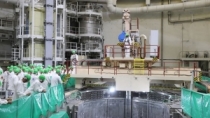VVER-1200 reactors maximize resilience of nuclear power plant to external, internal impacts

The loading of nuclear fuel into a VVER-1200 reactor of the first unit of the Belarusian nuclear power plant began on 7 August.
A Generation III+ unit with a VVER-1200 reactor boasts a number of advantages in comparison with units of the previous generation that rely on VVER-1000 reactors, Andrei Petrov noted. These advantages greatly enhance the unit's economic parameters and safety. A unique combination of active and passive safeguards that make a nuclear power plant extremely resilient to external and internal impacts is the main peculiarity of the VVER-1200 reactor.
For instance, all the power-generating units are fitted with a core catcher – a device able to prevent spillage if the nuclear reactor core melts down. The units are also fitted with other passive safeguards that can operate without human guidance and without power.
Apart from that, the output capacity of the reactor unit has been increased by 20%. The number of operational personnel has been reduced considerably. The designed service life of the primary equipment has been doubled from 30 years to 60 years, with an option to extend it by another 20 years.
At present the main customers of nuclear power plants with Russian-design Generation III+ units are Finland, Hungary, Turkey, Bangladesh, Egypt, and other countries.
Atomenergomash Company supplies key equipment for the nuclear island of the Belarusian nuclear power plant.
Fuel was made by Novosibirsk Chemical Concentrates Plant (NCCP, part of TVEL Fuel Company of the Russian nuclear industry corporation Rosatom). The enrichment level varies from 1.3% to 4.4%.
The Belarusian nuclear power plant is being built near Ostrovets, Grodno Oblast using the Russian design AES-2006 featuring two VVER-1200 reactors with the total output capacity of 2,400MW. The Russian state nuclear industry corporation Rosatom is the general contractor. Generation III+ reactor units boast improved technical and economic parameters.













